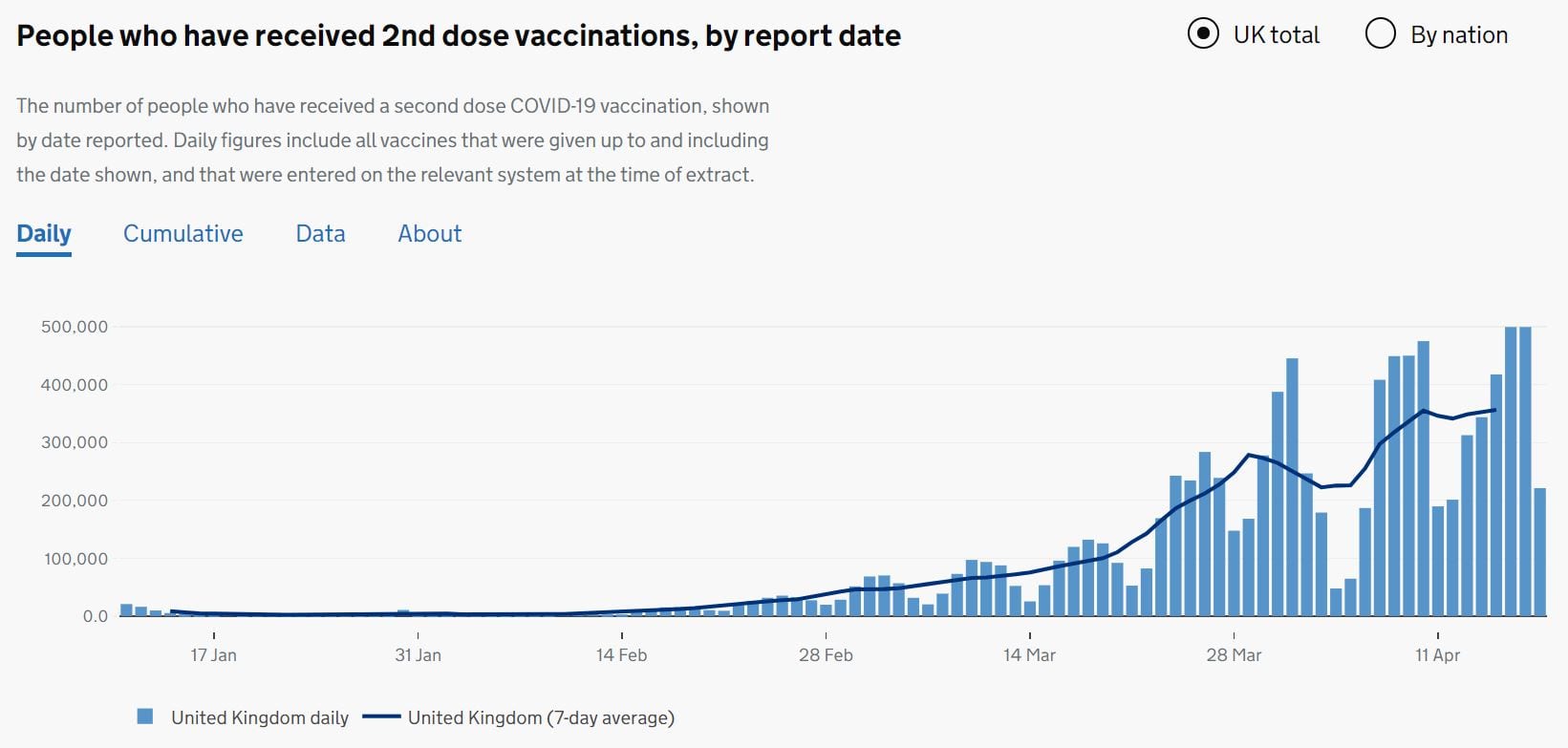I’ve previously written about how enterprises can adopt an event-driven mindset to become more real-time and responsive to unlock new business value. As a member of the public consuming the troves of data the government is publishing, it occurred to me there is a need for more real-time responsiveness here too. In this blog post I’ll explain the advantages the government can unlock, for both itself and the general public, by becoming event-driven. [Last update: April 2021]
With three vaccines now approved in the UK, it is a welcome bright light at the end of the tunnel in these extraordinary times. The general public is understandably anxious to see progress in the rollout and the return to a sense of normality. For those interested in closely following the detail, the government has been helpfully providing lots of metrics and reports on a dedicated data-sharing website: https://coronavirus.data.gov.uk/
To help us monitor the rollout progress, Sky News has added a vaccine doses ticker, alongside the usual FTSE share price index, to helpfully inform us exactly how many people the vaccine jab has been administered to. As of April 2021, we’ve passed the 10 million mark for 2nd doses and that is surely cause for some optimism and hope.
What drew my attention even more is that the two pieces of information on constant display – the vaccine ticker and the FTSE index – are very different in nature. The share price index continually updates as trading activity takes place throughout the day. While not all the changes will be shown on screen, it has the potential to update thousands of times in a single second. The underlying data behind the ticker can therefore be described as being “real-time”, meaning that as soon as there is a price change, we see the new value displayed on screen.
So it’s constant presence on the TV screen can be justified in that sense. See below for an example of how that number changes throughout the day:
The vaccination doses number, though, will report the same thing for hours. In fact, the number will be refreshed only once a day, in the morning; so the closer we get to the end of the day, the more out of date the number on the screen is.
But what if it did update more regularly and closer to real-time? What would that represent and why is that useful for the public or the government?
A real-time, event-driven flow of vaccination data would enable the government to have:
- Better insight to improve deployment speed by identifying trends and areas for process improvement
- Earlier reaction to issues for faster decision making, creating more “actionable” intelligence
As for the general public, we’d benefit from:
- A greater sense of reassurance and trust in the vaccine rollout progress
- More informed, empowered citizen journalism and government accountability
Being Event-Driven = Better Insight and Vaccine Deployment Improvements
Without having any inside knowledge of the government’s IT systems, an educated guess would be that they rely on batch processing. This is a traditional, and still very common, form of computing where things execute, or information is exchanged, periodically, usually on a set schedule. For example, the generation and distribution of a complex report once a day, perhaps during the overnight hours.
This educated guess is based on some things they say on their data sharing website:
One major drawback of a once-a-day batch processing approach is that the granular detail about how the vaccine administration is progressing within the day is lost. For example, notice the following progress graph at the current daily update granularity:
This data immediately tells us that:
- There is an ebb and flow nature to the vaccination progress on a day by day basis.
- The administration volume slowly ramps up from Monday each week to fall back down again by Sunday.
- The maximum daily number vaccinated in a given week is higher compared to previous weeks.
To turn insight into action: If the government were looking to further increase the vaccine deployment velocity they could look to improve each week’s “ramp up” time so that the day of the week with the most jabs administered perhaps starts from Monday or Tuesday, not Friday or Saturday, which seems to be the case right now. The government may look to identify and remove the obstacles that hinder the ramp up being achieved earlier in the week, like logistical issues around vaccine delivery or the ability for patients to be booked in for appointments.
If the daily summaries were this insightful, imagine what further insight could be gained if this information was available by the hour or minute. Maybe there is an ebb and flow that takes place across the hours of each day, and further improvement is possible to the vaccine deployment. It is only by shining a light onto the details that we can enable effective process improvement.
Being Event-Driven = Greater sense of trust and engagement
If news channels showed the vaccine progress as a continually updating number, it would create a sense of collective participation and uphold a feeling of hope while our most vulnerable members of society dutifully attend their appointments. We would be able to see, minute by minute, how we are slowly changing the tide against this pandemic.
This would no doubt have been the aim behind Sky News creating the ticker in the first place. However, the ‘staleness’ or ‘disconnect’ of that figure as the day goes on currently makes it less valuable. In fact, we know that the closer we get to the end of the current day, the more out of date the number is.
Being Event-Driven = Faster Reactions, Faster Decision Making
To explain a little more now on what being “event-driven” means; it is a way of describing and delivering the data that flows through an organisation’s IT systems, the key difference being that there is a new immediacy or “real-time” nature to it.
In the context of this vaccine delivery, NHS England reports there are ~1,791 vaccine delivery sites as of April 2, 2021. In the older method of ‘batch processing’, you can imagine each of these sites operating in isolation to record and track their vaccine delivery progress. Then at some interval, perhaps once a day (but I’d hope it was more frequent than that), each of these sites make their data available to a more central place so that it can all be added together to build the nation-wide view. From that point, the consolidated data is perhaps making its way to various parts of government and ultimately the public.
When operating in a new event-driven manner, each event in the real-world acts as the necessary data that IT systems consume and respond to. Example events would be like the following:
- Patient 1st Dose Vaccinated
- Patient 2nd Dose Vaccinated
Instead of waiting to report on the vaccination progress – by means of a large spreadsheet, for example – the event is created and sent as it takes place. Then on the receiving side, whoever is interested in the event, whether it is NHS England or the government directly, consumes them as they happen.
An event mesh would connect all the vaccine delivery centres and other relevant organisations, with the events themselves generated from a mobile app or click of a button in a web browser.
The event would not just tell you the vaccination took place, but could contain other necessary detail without compromising any personally-identifiable information (PII). Details such as the priority group the patient was in, vaccine center it took place, time of vaccination, etc.
Once operating in a fully event-driven manner, other examples could be:
- Vaccine Shipment Patriated
- An event for when each shipment has arrived into the country
- Vaccine Shipment Delivered
- An event for when a shipment has arrived at a centre
The government would be in a position to build a real-time view of all the moving parts that make up the vaccine delivery chain today. For instance, it can know instantly if there are any delays in import or transportation to be able to react accordingly.
To borrow a phrase from military, who is currently helping the vaccine rollout programme, these events become “actionable intel” due to their real-time nature.
Being Event-Driven = Empowering Citizen Journalism
I have to say the amount of data publicly available from the government is already a great starting point. In these testing times, transparency and accountability of government becomes all the more critical for a well-functioning democracy.
The desire for things to be more real-time is readily apparent in consumer behaviour, and the next step here is for the government to not just be a great provider of open data, but also make it real-time so it’s more actionable and relevant.
If the government is interested in joining the event-driven revolution, Solace is ready to help!

 Jamil Ahmed
Jamil Ahmed




